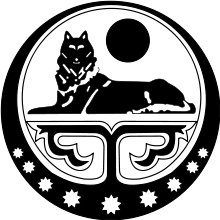Tukkhum
Tukkhum is a term and system introduced in the 1920s and 1930s, most notably by Soviet Chechen writer Magomed Mamakaev in 1934. This system does not properly apply to the Chechen nation and the social structure of Chechen clans.[1]
Mamakaev proposed that the Chechen tukkhum was a type of military-economic union between certain groups of teips, not through consanguinity but established for specific purposes, such as military alliances and for economic trade. That the tukkhum occupied a specific territory, which was inhabited by the members of the tukkhum. He also stated that each tukkhum spoke a different dialect of the same Vainakh language.[2]
Etymology
The term is of foreign origin and some suggest it comes from the old Persian word "tauhma" which meant kin or tribe.[3]:165-169 Tukkhum is a term often used by North Caucasians for a tribe or family, and is found among the Dagestani peoples such as Avars, Tabasarans, Kumyks and Lezghins.[4] The term is used to describe different clan structures for different ethnicities, and does not mean the same thing from one ethnicity to the other.
To Chechens it was introduced by Mamakaev in 1934 and it has been used in Chechen historical studies ever since. It is noted by the Caucasiologist Kharadze in 1968, that Mamakaev is the basis for the Chechen use of tukkhum, to make the social structure of the Chechens more complex and interesting. Despite the meaning of tukkhum not being clear in the Chechen language[3]:176
Proposed Tukkhum System

According to Mamakaev there were 9 Tukkhums:
- Äkkhiy
- Mälkhiy
- Nokhchmakhkakhoy
- Orstkhoy
- Terloy
- Chantiy
- Cheberloy
- Sharoy
- Shotoy
However this has been heavily criticized as some of the Tukkhums mentioned were in fact nothing more than large teips, with several "gar" (sub-clans). Teips such as Mälkhi and Terloy for example are traditionally 2 teips, consisting of several "gar". These teips have all the characteristics of a Chechen teip[5]. Mamakaev incorrectly wrote down these large teips as "tukkhum" and their gars as teips under this tukkhum, even though they were never teips, but merely branches of that specific teip.
References
- Nataev, Shapudi (2015). To the question about "Tuhum/Tohum/Tukhum/Tukham". p. 267-269. Retrieved 2 January 2020.
- Mamakaev, Magomed (1934). Чеченский тайп (род) в период его разложения (1973 ed.). Grozny. p. 16.
- Kharadze, R.L. (1968). "Некоторые стороны сельскообщинного быта горных ингушей". Кавказский этнографический сборник. Tbilisi: 165–169, 176.
- Khalilov, Madzhid (1984). Отраслевая лексика дагестанских языков. Makhachkala.
- Ilyasov, Lecha (2004). Тени вечности. Чеченцы: архитектура, история, духовные традиции. p. 332.